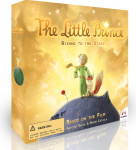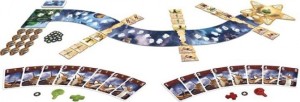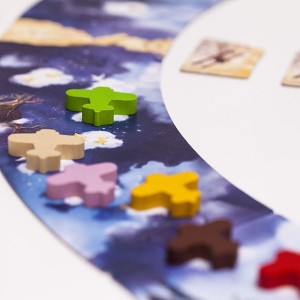Unplugged: The Little Prince: Rising to the Stars (Boardgame)
 Designers: Antoine Bauza, Bruno Cathala
Designers: Antoine Bauza, Bruno Cathala
Publisher: Ludonaute
Players: 2-6
Ages: 6+
Time: 15-30 minutes
Le Petit Prince (The Little Prince), protagonist of the third most translated book in the world, is back in the form of another boardgame. This time, it’s a young aviator who is leaving her grandfather’s house to fly to meet the little prince on his home planet. Players use cards to move their personal aviator across the map while collecting stars. The twist is in the turn order. The last place plane always takes the next move. The Little Prince is a quick little game that makes a good filler (a quick short game), but despite its art and straightforward rules it does have some aggressive play that may not fit well with younger players.
The board is constructed out of a start and end tile and three curved, middle tiles. Clouds on the tiles represent spaces on the game board. As players progress, they earn stars, whoever ends with the most stars wins the game. Players start with a hand of 8 hards and play them to move forward on the board any number of spaces up to the number on the card. In a curious twist, turns do not rotate around the board. Instead, whichever player is last on the board takes their turn. This could mean one player takes two turns in a row.
The cloud-spaces on the board are either blank or contain stars, telescopes, or birds. Landing on an occupied space lets a player exchange one of their own cards for a random one in the other player’s hand. Landing on an unoccupied space grants you that space’s bonus. Stars give players points, telescopes let players take a telescope token, and birds let a player draw from a special deck of cards. Telescopes grant a player extra stars, lose stars, or allow one to steal stars from other players. Special cards drawn from the bird symbol join the rest of the cards in a player’s hand. These typically grant fairly large movement bonuses. Gaining extra movement through cards is extremely important. There are 28 spaces (including the final planet) on the board and if a player uses each of their cards for maximum movement, they will only go 24 spaces. The first player to complete the course gains a 5 star token, with each subsequent finisher earning one star less.
The one other significant section of the game are three sections of story tiles. The three sections come at roughly one third, two thirds, and near the end of the race. When the first player crosses one of these sections they select one of four face up tiles or one of the two face down tiles at that location. Later players select story tiles from those that are remaining. These tiles grant extra stars, from one to five points, with the higher point tiles much rarer. The one point tiles come in two versions. Collect both kinds of the one point tiles and you score a bonus 6 points (for a total of 8.) Careful, though, as they may be in high demand and players are only able to collect three total story tiles.
The game ends with all players have run out of cards. (Players who complete the course discard their remaining cards.) The player with the most stars wins, with ties broken in favor of the player who first completed the course.
Verdict:
I love the idea of the lasts player taking the next turn. It has been seen before, but it is a great fit here. When combined with the very limited movement cards, the game is a careful balance between staying last while not using too many cards. Staying last gives one more actions, but moving slowly consumes cards. Move too slowly and risk running out of cards before the end of the game.
I love nearly everything about the game, the gameplay, the art, and the simple-to-grasp rules. However, the telescope tiles are my main concern. They are a luck-fest. Final scores are commonly in the high teens and are often tightly fought. Getting lucky on one or two telescopes can swing the game. This may be forgiven in light of the game’s quick play, making it a decent quick, filler game. It can also be seen as a skill-leveler, giving less experienced gamers a shot at the win.
My other concern with the telescopes lies with the ability to directly attack other players (to steal their stars.) This results in king-making, where one player can determine the winner even if they aren’t in contention. The game claims it is for ages 6+, but when played with younger gamers, negative effects often engender hard feelings.
As a result, I can’t give it a recommendation as a family game for all ages. The conflict involved in the telescopes makes it less suitable for the youngest gamers, and better for young teens and up. However, the art and theme of the game match up so well with the younger set, it makes a strange contrast with the game play. As a filler, I found it quick and fun, but I’m going to have to wait awhile before I can bring it to the table in my own home.







November 19th, 2015 at 6:09 pm
I read somewhere that The Little Prince book inspired Katamari Damacy.
November 19th, 2015 at 6:10 pm
I could believe that… I saw a few photos of Katamari Damacy when looking for Little Prince photos..